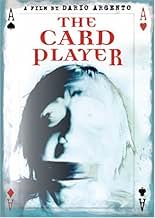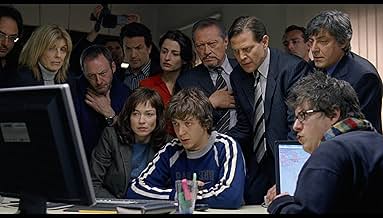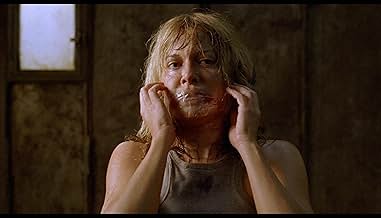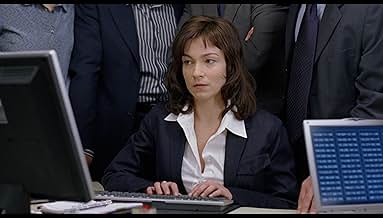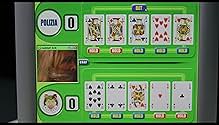IMDb रेटिंग
4.9/10
5.8 हज़ार
आपकी रेटिंग
अपनी भाषा में प्लॉट जोड़ेंA Rome policewoman teams up with a British Interpol agent to find a crafty serial killer who plays a taunting game of cat-and-mouse with the police by abducting and killing young women and s... सभी पढ़ेंA Rome policewoman teams up with a British Interpol agent to find a crafty serial killer who plays a taunting game of cat-and-mouse with the police by abducting and killing young women and showing it over an Internet web cam.A Rome policewoman teams up with a British Interpol agent to find a crafty serial killer who plays a taunting game of cat-and-mouse with the police by abducting and killing young women and showing it over an Internet web cam.
- पुरस्कार
- कुल 1 नामांकन
Pier Maria Cecchini
- Flying Squad Chief
- (as Piermaria Cecchini)
फ़ीचर्ड समीक्षाएं
The Card Player' directed and co-authored by leading Italian filmmaker, Dario Argento is quite different from what I expected, based on Argento'' reputation based on his best known film, the horror classic, 'Suspiria' of about 20 years ago. This movie is much less Wes Craven and much more Alfred Hitchcock, although I think Argento does not quite measure up to the Great Hitchcock in his use of subtlety and surprise, although there are a few good surprises in this film.
While this movie was made by a thoroughly Italian cast and crew, except for Irish actor, Liam Cunningham, almost all the original dialog as we hear it in the film was spoken in English as it was filmed. Mistaking this for a horror film was easy based on the cover art and some of the blurbs on the package. And, these hints are not entirely misleading, as there is a fair amount of intentional horror based on a fairly extended threat of death to a victim seemingly unable to free herself from the situation, unlike Hitchcock's secret threat, suddenly sprung on the unsuspecting victim as in 'Psycho'.
The mechanics and most business of the story are ultramodern. The victims are kidnapped, bound, and gagged (albeit a bit amateurishly), and the prep sends an e-mail to a female police detective that in order to free the Vic, the police will need to have someone play computer poker with the prep, freeing the Vic by winning two out of three hands. The first victim is a British tourist, bringing the Irish detective attached to the UK consulate in Rome into the case. And, this detective happens to be a forensics expert, so a lot of his early investigations are straight out of the 'CSI' casebook. Although, none are so modern that you couldn't see almost the identical business in a movie made 50 years ago, just as you see them in the murder / suicide investigation scene in Fellini's 'La Dolce Vita'.
Not only is the plot much more a thriller than a horror show, but the quality of the acting, directing, and camera work is high as well. Unfortunately, I feel the writing, in the implausibility of many plot turns, is just a bit too weak. While Argento may be one of the best known Italian filmmakers working today, his scripts fall far short of the great plot and dialog of Fellini and Bertolucci.
One of the very first weaknesses is in the way the police failed to play the contact with the prep. Given the chance to bring in an expert poker player to play the hands, that task falls wholly nilly to the female detective who is not only a poor poker player, but has a monkey on her back about gambling and poker, as her father committed suicide after a failure at cards. For the second kidnapping, the police happen upon a detective who knows something about poker, but who fails nonetheless. Only with the third victim do the police enlist the assistance of an expert computer poker player, who succeeds in effecting the release of the victim.
Explaining more implausibilities starts to give away some of the better parts of the plot, so I will stop there and note that this DVD has my very favorite feature, an audio commentary running the entire length of the film. The commentary is by the cinematic author, Alan Jones rather than by the director or his co-author or producer, but it's pretty good. Since, as the commentator notes, Argento does not film in any of the well-known tourist locations (except for a brief glimpse of the Pantheon and a scene in the Tiber), but in the 'real' bourgeois' Rome. So, commentator Jones gives us an orientation for where we are in Rome and on the events which help us understand the plot. He also points out the virtually total absence of blood in the film, which was a conscious decision by the director, since so many of his other films are so singularly bloody.
While this movie was made by a thoroughly Italian cast and crew, except for Irish actor, Liam Cunningham, almost all the original dialog as we hear it in the film was spoken in English as it was filmed. Mistaking this for a horror film was easy based on the cover art and some of the blurbs on the package. And, these hints are not entirely misleading, as there is a fair amount of intentional horror based on a fairly extended threat of death to a victim seemingly unable to free herself from the situation, unlike Hitchcock's secret threat, suddenly sprung on the unsuspecting victim as in 'Psycho'.
The mechanics and most business of the story are ultramodern. The victims are kidnapped, bound, and gagged (albeit a bit amateurishly), and the prep sends an e-mail to a female police detective that in order to free the Vic, the police will need to have someone play computer poker with the prep, freeing the Vic by winning two out of three hands. The first victim is a British tourist, bringing the Irish detective attached to the UK consulate in Rome into the case. And, this detective happens to be a forensics expert, so a lot of his early investigations are straight out of the 'CSI' casebook. Although, none are so modern that you couldn't see almost the identical business in a movie made 50 years ago, just as you see them in the murder / suicide investigation scene in Fellini's 'La Dolce Vita'.
Not only is the plot much more a thriller than a horror show, but the quality of the acting, directing, and camera work is high as well. Unfortunately, I feel the writing, in the implausibility of many plot turns, is just a bit too weak. While Argento may be one of the best known Italian filmmakers working today, his scripts fall far short of the great plot and dialog of Fellini and Bertolucci.
One of the very first weaknesses is in the way the police failed to play the contact with the prep. Given the chance to bring in an expert poker player to play the hands, that task falls wholly nilly to the female detective who is not only a poor poker player, but has a monkey on her back about gambling and poker, as her father committed suicide after a failure at cards. For the second kidnapping, the police happen upon a detective who knows something about poker, but who fails nonetheless. Only with the third victim do the police enlist the assistance of an expert computer poker player, who succeeds in effecting the release of the victim.
Explaining more implausibilities starts to give away some of the better parts of the plot, so I will stop there and note that this DVD has my very favorite feature, an audio commentary running the entire length of the film. The commentary is by the cinematic author, Alan Jones rather than by the director or his co-author or producer, but it's pretty good. Since, as the commentator notes, Argento does not film in any of the well-known tourist locations (except for a brief glimpse of the Pantheon and a scene in the Tiber), but in the 'real' bourgeois' Rome. So, commentator Jones gives us an orientation for where we are in Rome and on the events which help us understand the plot. He also points out the virtually total absence of blood in the film, which was a conscious decision by the director, since so many of his other films are so singularly bloody.
After getting almost unanimously negative reviews, I was dreading watching IL CARTAIO. It turns out that the film is not bad at all. No, it's not another SUSPIRIA, but nor is it a PHANTOM OF THE OPERA, thankfully. People keep going on about the absence of Argento's trademark style. Well, I want to know what style that would be? Suspiria's? Phenomena's? The Stendhal Syndrome's? I think you get my point. Argento doesn't have one single style -- he had many, and I think that Il Cartaio's style is different rather than absent. I personally liked the camerawork and the cold look of the film. The use of shadow is really good, and I think this has got to be the only film Argento has done that is obviously set in the winter. It gave everything an eery look.
It's a tightly constructed little thriller with a lot of very tense set-piece scenes. The lack of gore confused me a bit, but everyone seems to forget the impalement of a certain character. That, to me, was pretty gory although admittedly not flamboyant. In many ways it seems a lot like the antithesis of Non Ho Sonno, which was extremely over the top in terms of violence.
I think Tenebre was the last film Argento did that received almost unanimous critical acclaim on its initial release. All of his other triumphs since then have grown on people over the years. I don't think Il Cartaio will be any different.
It's a tightly constructed little thriller with a lot of very tense set-piece scenes. The lack of gore confused me a bit, but everyone seems to forget the impalement of a certain character. That, to me, was pretty gory although admittedly not flamboyant. In many ways it seems a lot like the antithesis of Non Ho Sonno, which was extremely over the top in terms of violence.
I think Tenebre was the last film Argento did that received almost unanimous critical acclaim on its initial release. All of his other triumphs since then have grown on people over the years. I don't think Il Cartaio will be any different.
I have read the reviews complaining about that Dario has abandoned his style and all the gore to produce a tame TV-thriller. Far from the truth, according to me! I really think that this is the best he has done since "Opera". Granted, his stylish touch might seem to be muted compared to the baroque thriller of the 70s and 80s, but this cold and bleak atmosphere that he conjures up this time along with very brightly lit camera-work for most of the scenes, is something I enjoyed throughout! Sure, the gore is almost totally absent (apart from one scene), but as a whole this picture is much more efficiently done. The pace is fluent and unlike most of his other movies, there is actually no point where the characters just stand around and talk (and sometimes his players have been involved in some truly atrocious conversation) to fill out the time.
*MINOR SPOILER* And in "Il cartaio" the three main actors are actually very good! They are people you can care about and when they are in danger or die, you feel sorry for them. *END OF SPOILER* Like I mentioned before, I enjoyed the bleak look of the movie...as always classy camera-work in every frame of an Argento picture! And Claudio Simonetti's score is his best in years even though you might be just a little bit tired of it by the time the movie reaches it's conclusion. And talking about the finale, I found it both interesting, but at the same time also maybe a little bit of a letdown. However, the endings have been a bit weak lately in Dario's films. Not since "Tenebrae" has there been a really powerful conclusion. And two minor complaints finally...it was too easy to guess who the killer was. This has been mentioned before and I think it is true. The killer's identity could have been better camouflaged without a "certain scene" (you will know which one). And the card scenes went on too long on two occasions. The constant screaming from the victims became annoying in these scenes and I almost wanted them to die just to make them shut up! Otherwise, his best work in years and a film where he is not just content with repeating an old formula (like in "Sleepless" which I liked anyhow), but is actually trying to find a whole new path in his art.
*MINOR SPOILER* And in "Il cartaio" the three main actors are actually very good! They are people you can care about and when they are in danger or die, you feel sorry for them. *END OF SPOILER* Like I mentioned before, I enjoyed the bleak look of the movie...as always classy camera-work in every frame of an Argento picture! And Claudio Simonetti's score is his best in years even though you might be just a little bit tired of it by the time the movie reaches it's conclusion. And talking about the finale, I found it both interesting, but at the same time also maybe a little bit of a letdown. However, the endings have been a bit weak lately in Dario's films. Not since "Tenebrae" has there been a really powerful conclusion. And two minor complaints finally...it was too easy to guess who the killer was. This has been mentioned before and I think it is true. The killer's identity could have been better camouflaged without a "certain scene" (you will know which one). And the card scenes went on too long on two occasions. The constant screaming from the victims became annoying in these scenes and I almost wanted them to die just to make them shut up! Otherwise, his best work in years and a film where he is not just content with repeating an old formula (like in "Sleepless" which I liked anyhow), but is actually trying to find a whole new path in his art.
I was among those who felt that Argento lost his touch after TENEBRAE (1982), and that his output during the last 20 years or so was just a pale shadow of his best work (with the truly lamentable 1998 version of THE PHANTOM OF THE OPERA being the worst of all). While all these films contained some interesting elements, they failed to jell into a satisfying whole; the same, therefore, can be said of his latest offering.
THE CARD PLAYER was originally intended as a sequel to THE STENDHAL SYNDROME (1996), which had starred the director's talented daughter Asia: however, in the interim she had turned her attention to directing small, personal films and at the time of the proposed shooting was staying in the U.S.; so, the lead character's name and background had to be slightly changed to accommodate a new actress Stefania Rocca. Unfortunately, the days when Argento's unique visual style was alone worth the price of admission are long gone and, despite a few distinct touches here and there (with the best sequence being when Rocca is stalked at night by the killer in her own house), THE CARD PLAYER looks and feels distressingly like the typical made-for-TV movie that fills up the tube's schedule in Italy virtually every week (the fact that the film is considerably less gory than his earlier stuff, with the majority of the murders taking place off-screen, or that none of the cast members other than Rocca herself are well-known, let alone overseas, only adds to this impression)! At least, regular collaborators Claudio Simonetti (music score) and Sergio Stivaletti (make-up effects) are on hand to offer their consistently reliable input
Anyway, the cat-and-mouse thriller plot (once one gets over the silly premise that the Police would accept the challenge of a poker game with the killer, even if the prize is the life of a hostage) is intriguing and compelling enough for the most part but characterization is alarmingly shoddy (despite its attempt to create a romantic situation between Rocca and Liam Cunningham, the latter sent by the British Embassy in Rome to investigate the murders), while the eventual revelation and subsequent climax involving a speeding train are quite a disappointment (though, from what little I recall of Argento's later work, at least OPERA [1987] and SLEEPLESS [2001] were also given lame endings)!
THE CARD PLAYER was originally intended as a sequel to THE STENDHAL SYNDROME (1996), which had starred the director's talented daughter Asia: however, in the interim she had turned her attention to directing small, personal films and at the time of the proposed shooting was staying in the U.S.; so, the lead character's name and background had to be slightly changed to accommodate a new actress Stefania Rocca. Unfortunately, the days when Argento's unique visual style was alone worth the price of admission are long gone and, despite a few distinct touches here and there (with the best sequence being when Rocca is stalked at night by the killer in her own house), THE CARD PLAYER looks and feels distressingly like the typical made-for-TV movie that fills up the tube's schedule in Italy virtually every week (the fact that the film is considerably less gory than his earlier stuff, with the majority of the murders taking place off-screen, or that none of the cast members other than Rocca herself are well-known, let alone overseas, only adds to this impression)! At least, regular collaborators Claudio Simonetti (music score) and Sergio Stivaletti (make-up effects) are on hand to offer their consistently reliable input
Anyway, the cat-and-mouse thriller plot (once one gets over the silly premise that the Police would accept the challenge of a poker game with the killer, even if the prize is the life of a hostage) is intriguing and compelling enough for the most part but characterization is alarmingly shoddy (despite its attempt to create a romantic situation between Rocca and Liam Cunningham, the latter sent by the British Embassy in Rome to investigate the murders), while the eventual revelation and subsequent climax involving a speeding train are quite a disappointment (though, from what little I recall of Argento's later work, at least OPERA [1987] and SLEEPLESS [2001] were also given lame endings)!
One of the the great things about giallo is the blood and nudity. The serial killer takes the time to undress his victim before tossing her in the water, so we get to see everything.
A little Saw and a little "CSI"/"Criminal Minds"; this film features a new gimmick. We'll play cards for the life of a girl.
As the game progresses, the killer ups the ante by capturing the Police Commissioner's daughter and forcing the police to play for her life.
As the police close in on the Card Player, he manages to get Anna Mari in his clutches and forces her to play a game for her life. It was something of a silly ending.
A little Saw and a little "CSI"/"Criminal Minds"; this film features a new gimmick. We'll play cards for the life of a girl.
As the game progresses, the killer ups the ante by capturing the Police Commissioner's daughter and forcing the police to play for her life.
As the police close in on the Card Player, he manages to get Anna Mari in his clutches and forces her to play a game for her life. It was something of a silly ending.
क्या आपको पता है
- ट्रिवियाWhen Anna (Stefania Rocco) is attacked in her home, (suddenly) a pair of dismembered fingers are shown; this is left in / over from shots not included the film, first inferred when John (Liam Cunningham) inspects / lifts the first victim corpse's arm in the mortuary, and then to the water recovered victim, which in a short location 'making of' documentary, is shown as also had missing fingers.
- गूफ़Boom mic visible at the top when English detective comes and insulting begins.
- भाव
John Brennan: THIS IS FUCKING BOLLOCKS!
- कनेक्शनReferenced in Ti piace Hitchcock? (2005)
टॉप पसंद
रेटिंग देने के लिए साइन-इन करें और वैयक्तिकृत सुझावों के लिए वॉचलिस्ट करें
- How long is The Card Player?Alexa द्वारा संचालित
विवरण
बॉक्स ऑफ़िस
- बजट
- €20,00,000(अनुमानित)
- दुनिया भर में सकल
- $33,68,452
- चलने की अवधि
- 1 घं 43 मि(103 min)
- रंग
- ध्वनि मिश्रण
- पक्ष अनुपात
- 1.85 : 1
इस पेज में योगदान दें
किसी बदलाव का सुझाव दें या अनुपलब्ध कॉन्टेंट जोड़ें



